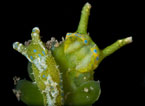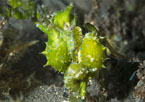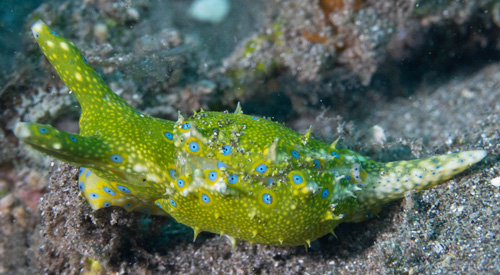| Home |
| Acknowledgments |
| Conventions |
| Glossary |
| Maps |
| References |
| Links |
| Articles |
| Thumbnails |
| Species
list |
| Family |
| Next
species |
Additional Photos

side

front

"tail" & foot

young

old

bi-colored "tail"

regenerating

feeding

group

mating

with eggs

Oxynoe jordani Krug, Beriman & Valdes, 2018

| Maximum size: 47 mm (including "tail"). Identification: This species has a thin, transparent shell that's covered by undivided parapodia. The body is papillate and the foot extends well beyond the posterior margin of the shell. The posterior portion of the foot appears to increase in relative length as it grows. (Note 1) It is light olive-green with yellow flecks and white blotches. The body is decorated with gold-ringed, blue ocelli that have dark blue dots in their centers. (Note 2) Blue ocelli are also present on the body under the shell (showing through the shell in young animals). Natural history: Numerous Oxynoe jordani were recently found, on Maui, in patches of Caulerpa taxifolia growing in a patchy Halimeda kanaloana bed at a depth of about 9 m (29-30 ft). The lack of records between the 1800s and 2021 suggests that the species may be very sporadic in occurrence. (Note 3) It feeds on Caulerpa taxifolia and lays flattened, cream egg masses. It's diurnally active and uses it's flexible foot margins to grasp the Caulerpa's fronds. (Note 4) Like other members of its genus, it secretes a milky fluid containing ichthyotoxic compounds (when disturbed) and may autotomize the posterior portion of its foot to distract predators. (Note 5) Distribution: Maui and Oahu: also known from the western Pacific and French Polynesia. Taxonomic notes: The genus Oxynoe was first reported from Hawaii by Adams in 1855 (described as Lophocercus krohnii). His description, however, was based only on the shell. Morch, in 1863, reported the genus from the "Sandwich Islands" using the name Lophocercus viridis Pease 1861 (since changed to Oxynoe viridis and originally described as "from the Pacific Islands"). Neither the shell description by Adams nor the Morch record can be clearly assigned to either O. jordani or O. viridis as illustrated in Gosliner, et. al. (2018). Therefore, although it's possible that the older records were a different species, we're lumping the new animals with them by "process of elimination." If it becomes possible at some point to separate them, Katherine Shepherd and Jenna Szerlag should be credited with the first record of O. jordani. Photo: Rebecca Bicker: "tail" regenerating: Maalaea Bay, Maui; Feb. 14, 2021. Observations and comments: Note 1: Autotomization and regeneration might be an alternative explanation for the variation in "tail" length. Note 2: The blue spots with gold rings aren't as precisely matched to the blue and gold ocelli found in the sea hares Stylocheilus striatus and Phycophila euchlora as are the markings in some other possible mimics. But, perhaps they are close enough so that Oxynoe jordani is still deriving some benefit from the resemblance (since the sea hares are known to concentrate toxins from the cyanobacteria they eat)? Note 3: Previous Oahu records from the 1800s lack habitat data. Note 4: On Feb. 14, 2021 Katherine Shepherd and Jenna Szerlag found 10 animals on a 4 m (15 ft) diameter patch of Caulerpa taxifolia growing in a patchy Halimeda kanaloana bed. They ranged from 17 to 40 mm in length and could "stretch out longer." They were observed feeding actively on the Caulerpa and crawling between clumps. Several were resting on egg masses. Note 5: Gosliner, et. al. (2018) mentions that Oxynoe spp use their "tales" as a "propeller to swim away from danger." However, Rebecca Bicker observed that two animals flipped up into the water column (but not molested, further) did not display that behavior. Jenna Szerlag and Katherine Shepherd also observed the same lack of "tail" motion in a third disturbed animal. Meanwhile, Lewin (1970) states that: "When Oxynoe panamensis is persistently irritated mechanically, it responds by strong lateral movements of the tail, which is eventually detached at its anterior junction, just behind the visceral hump." Perhaps, the "tail" movements are better viewed as a "pre-autotomization" defensive behavior rather than as a swimming behavior? In other words, that they function primarily by eliciting a startle response from a predator (or presenting a warning display) in a manner analogous to mantle flaring in Lobiger viridis? Or, that they allow an animal to physically break free from a predator that's restraining it? Two of the disturbed animals were also observed emitting milky fluid while in the water column suggesting that doing so is a typical response to that degree of disturbance. |
| Thumbnails |
Species
list |
Family | Next species | Top |